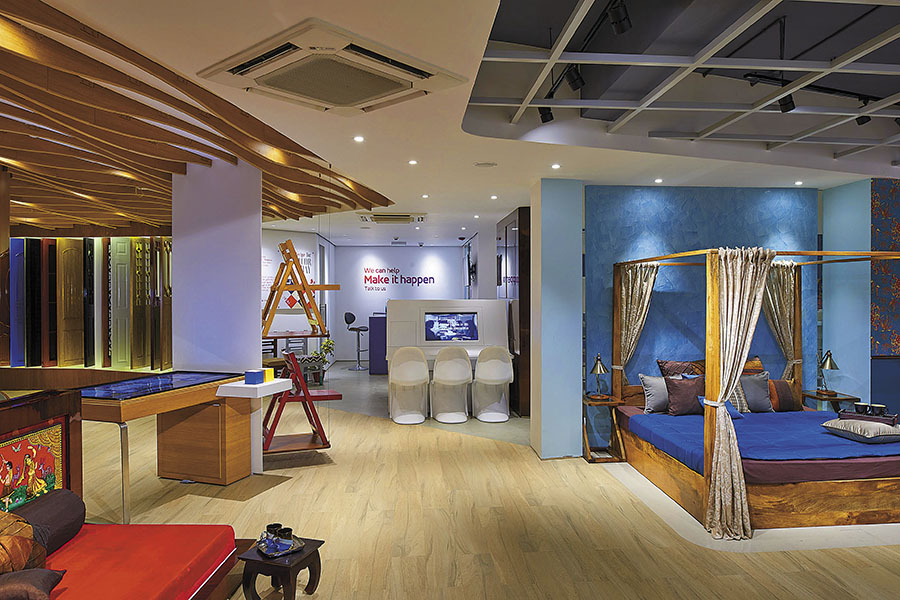
KBS Anand: Taking Asian Paints to homes and beyond
Asian Paints has been a faithful painting partner for millions of house owners across India. Now, its CEO KBS Anand plans to extend the company's offerings to other parts of their homes

The biggest eye-opener was that no one is interested in paint,” says Kanwar Bir Singh (KBS) Anand, managing director & chief executive officer, Asian Paints. This was in 2000 after a year-long customer engagement exercise by Asian Paints. And even for a 21-year veteran of the company, at the time, the finding was a revelation.
Things might have changed since then but one thing has remained—Asian Paints, founded by Champaklal Hiralal Choksey in 1942 and the market leader since 1967, has over the years only managed to strengthen its lead.
Whether it is being at the forefront of recruiting from the Indian Institutes of Management or installing the first mainframe computer or doing demand forecasting, Asian Paints has always been a company that has set the path for the industry to follow.
Its own path, over the last 16 years, was set by the findings of the customer engagement. “It laid the blocks for almost all the new initiatives the company made over the next decade and a half,” says Anand.
It is the same research that has made Asian Paints expand, over the last two years, from its traditional paints business to the customer’s home in a bigger way—Asian Paints has forayed into kitchen and bathroom fittings as well. What’s more, even furniture can be bought from the Homes with Asian Paints stores that the company has started setting up—the first of these stores was opened in Coimbatore in March this year. “It’s too premature to discuss numbers,” says a discreet Anand, but there is no doubt that after the company made paints interesting, it is now taking baby steps into a future where it would be known as much more than a paint company.

The Journey
To understand Anand’s recent moves, it makes sense to rewind to 2000-2001 and the lessons learnt then. Anand recalls sitting in on one of the customer engagement sessions in Bengaluru. Till then, the company had thought of itself as a typical FMCG business. It had pioneered the direct delivery of paints to dealers, something everyone in the industry does now. Its order-fill rates—the percentage of overall orders that are executed—were in excess of 95 percent every day. But the company also realised that though the paints business was a very low-involvement category (a customer usually deferred to the paint dealer or painter’s advice), the returns for the customer were high: After painting the house, all customers reported an increase in self-esteem.
For instance, at the Bengaluru session, one customer said he painted his house every Diwali. This surprised Anand, who was sitting in the adjacent room and would periodically ask the interviewer to ask more questions. What emerged was that the customer couldn’t afford to buy anything substantial during Diwali but for Rs 1,500 he could get his whole house painted. It was an insight that led to two conclusions: First, since Asian Paints was the only brand customers knew and asked for by name, the company should leverage on the brand, and second, it should look at how they could enter newer areas and get customers more involved.
In the immediate aftermath of the customer surveys, the company introduced the Royale brand and an array of textures, which went down well with the users. Asian Paints also started marketing paints in small packs. Priced at Rs 80-90, these gave customers a chance to paint a small part of the wall in their houses and then come back for larger packs to complete the job. “We were pleasantly surprised with the response,” says Anand.
This success in turn led the top management at Asian Paints to conclude that the customer wanted choices and was hungry for more information. Enter the Colour with Asian Paints store.

In 2007, in Mumbai’s tony suburb of Bandra, Asian Paints launched a paint store unlike any seen before. Spread over 5,000 square feet, its aim was to provide customers with advice on painting and decorating their homes. Customers would come in and spend time with a ‘colour consultant’ who would work with them on various paint types, different shades and textures. Advice on accessories like wallpaper and stencils was also given. Most importantly, there was no expectation to buy. It was an exercise in customer engagement. Women and children loved the place and the feedback was overwhelmingly positive. “This was the first time the company was interacting with the customer directly and we realised there was a huge hunger for information,” says Anand. A text messaging service through which customers were sent a booklet on paints yielded a stunning 300,000 queries in the first year. The queries doubled in the second year. While these stores created an incredible brand connect, the cost of operations was prohibitive and the company had to restrict the stores to Mumbai, New Delhi and Kolkata.
It ended up doing the next best thing, i.e. setting up much smaller versions of these stores within dealer shops across the country. These 600 square feet Asian Paints Colour Ideas stores offer advice on painting and colours and the company subsidises the cost of the consultants.
The company now also offers colour consultancies at home, and last year it did 260,000 visits.
Moving Beyond Paints
All these steps of reaching out to the customer over a decade resulted in the growing belief that the company could move beyond just paints. The steps taken since 2002 gave the company a certain critical mass. It had an immense cash pile to deploy.
In 2009, Anand and his then boss PM Murty, the former CEO of Asian Paints, evaluated a whole range of businesses, what Anand describes as, “every conceivable business opportunity”. When prodded he cites IT—where Asian Paints was already doing a lot of in-house work such as predictive demand analysis and software for automation of factories—telecom and water, as areas they explored getting into.
However, the core expansions that finally occurred were closer home. It unfolded like this: When Murty and Anand were examining various businesses, they also got a glimpse of the evolving retail landscape in the country.
In mature markets like the US, paint retailing was done through big boxes (like Walmart and Costco), company-owned stores and mom-and-pop stores (the equivalent of Asian Paints dealers). Of these, big box retailers would squeeze the paint companies for margins; the mom-and-pop stores provided the best service, were open 24x7 and so managed to hold their own against company-run- and big box retailers.
If such organised retail took off in India, the company’s retail dominance could be under threat. Asian Paints also felt that while the West has a significant portion of DIY, or do-it-yourself, customers, the number in India is very low—0.5 percent, Anand estimates.
Moreover, research by Ambit Capital shows that though the cost of painting was split 10:90 between labour and paint in 1980, it is now 62:38. By 2036, it is estimated to become 88:12. With such high labour costs, it is possible that a large number of Indians will also move to DIY painting.
“If big box becomes a reality who is going to be under threat? The company and the retailer,” says Anand. “So it was best to partner with the retailer and the thought came from there.” Asian Paints, as a result, set up Homes with Asian Paints. As with paints, the woman of the house makes the major decor decisions; also, kitchens and bathrooms are the two areas where there is maximum spend and involvement.
Accordingly, for kitchens, the company bought a majority stake into homegrown brand Sleek in 2013; for bathrooms, it acquired the front-end (and not the manufacturing) part of the Ess Ess bath fittings business in 2014.
The clearest indication of Asian Paints’ plans comes from the large-format store the company has inaugurated in Coimbatore. At the dealer-owned 4,000 sq ft store, customers can buy lighting from Philips, furniture from Pepperfry, D’Decor furnishings, sanitaryware by Hindware and Somany Ceramics’ tiles in addition to kitchen and bath fittings. The aim is to have a one-stop shop for home needs. Anand says it is too early to talk about the success of the store, but admits that the learning curve is steep and the furniture category “which requires local adjustments and is often custom-made” has not done so well.
The location of the store also makes a significant difference. But Asian Paints, leveraging on in-house skills, has provided the IT backbone for the store and facilitated the design and customer experience. Customers can get a 3D rendering of what their house will look like, a feature that has proved to be a success.
With Homes with Asian Paints, the company has put in place a fledgling attempt to take on big box retail if and when the category grows in India. The aim is, again, to be in a position to drive the direction of the industry once retailing matures over the next decade.
“As far as India is concerned, we believe we have reached a stage where we can push the envelope on these adjacencies,” says Jalaj Dani, president, supply chain, HR and chemicals at Asian Paints.
“Asian Paints is not only the most exciting paint company but also one of the most interesting consumer companies in India. Its innovations in supplying directly to dealers [they have no distributors], professionalising management, using IT in demand forecasting and planning and automating factories and now driving the next leg of evolution in the decorative paint industry, have been trendsetters,” says Rakshit Ranjan, consumer analyst at Ambit Capital.
As modern retail in India has stuttered, there is an opportunity for Asian Paints to understand the home retail business and given their predilection for being ahead of the curve, it could become an important company in this space.
Crucially, they have chosen to not spend a lot of money initially—it is more a try-things-out-and-see-what-works approach.
“It is too early to tell whether this will be dilutive of our return on capital employed,” says Jayesh Merchant, CFO and company secretary and president, industrial JVs at Asian Paints.
While it is still premature to talk about the success of the initiatives; if Asian Paints’ past record on consumer understanding is anything to go by, it’s fair to say their home retail move has a good chance of success.
If so, Anand will leave a rich legacy that the company can draw on for years to come.
(This story appears in the 30 November, -0001 issue of Forbes India. To visit our Archives, click here.)
X







